Chap10 | Mass-Storage Structure#
Overview#
Magnetic disks provide bulk of secondary storage of computer system.
hard disk is most popular.
Disk Structure#

可见 DB 笔记
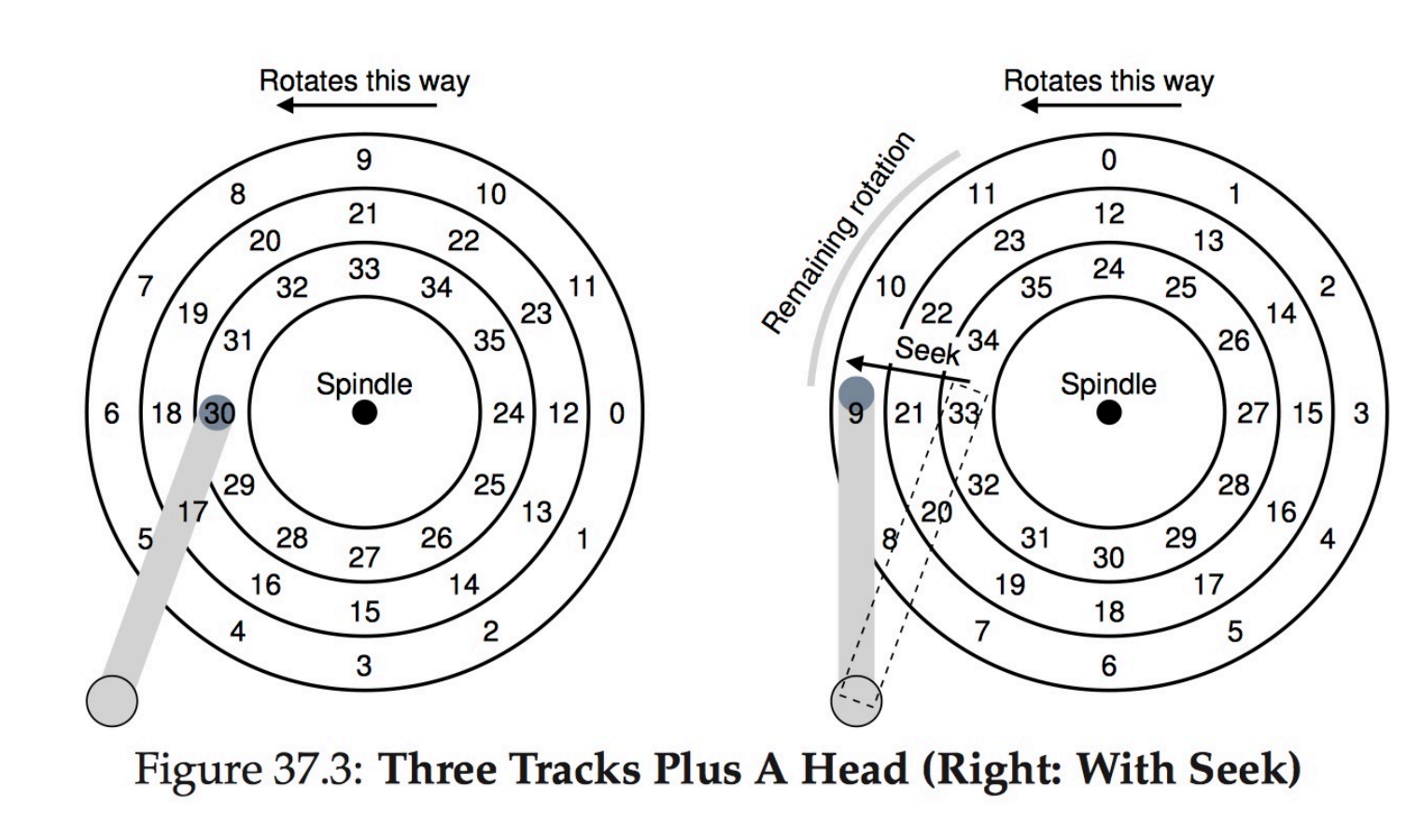
-
Positioning time(random-access time) is time to move disk arm to desired sector
- seek time: move disk to the target cylinder
- rotational latency: for the target sector to rotate under the disk head
-
Performance
- transfer rate: theoretical 6 Gb/sec; effective (real) about 1Gb/sec
- seek time from 3ms to 12ms (9ms common for desktop drives)
- latency based on spindle speed: 1/rpm * 60
- average latency = ½ latency
time计算考试会考
Example
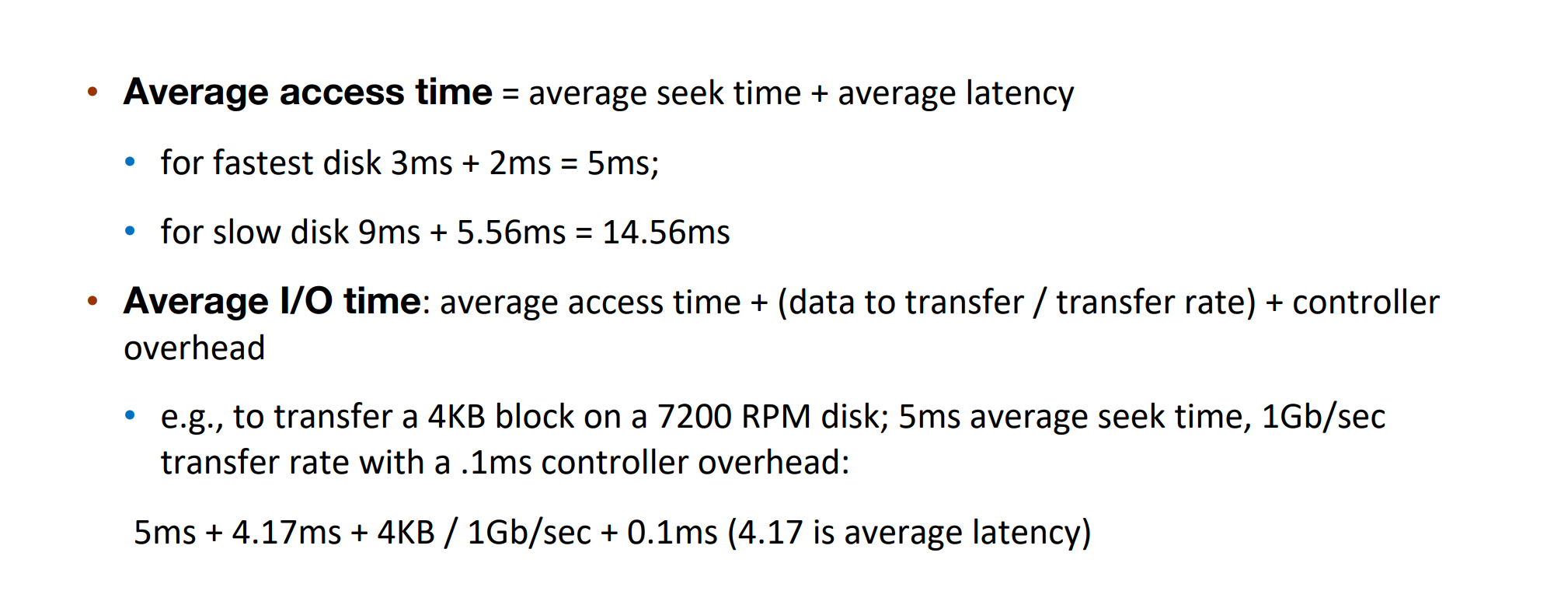
主要慢在 seek 和 rotation 部分。
Disk Scheduling#
磁盘也需要调度,以减少 access time。
以前 OS 会负责调度,现在由 firmware 负责(disk controller)。
There are many disk scheduling algorithms
- FCFS
- SSTF
- SCAN, C-SCAN
- LOOK, C-LOOK
We use a request queue of cylinders “98, 183, 37, 122, 14, 124, 65, 67” ([0, 199]), and initial head position 53 as the example.
注意这里说的是 cyclinder 柱面(包含若干等距离的 track),只有不在同一柱面的才需要 seek,同一柱面不同 track 不需要动磁头,不同 sector 就靠转动。
FCFS#
First-come first-served, simplest scheduling algorithm.
Example
Total head movements of 640 cylinders
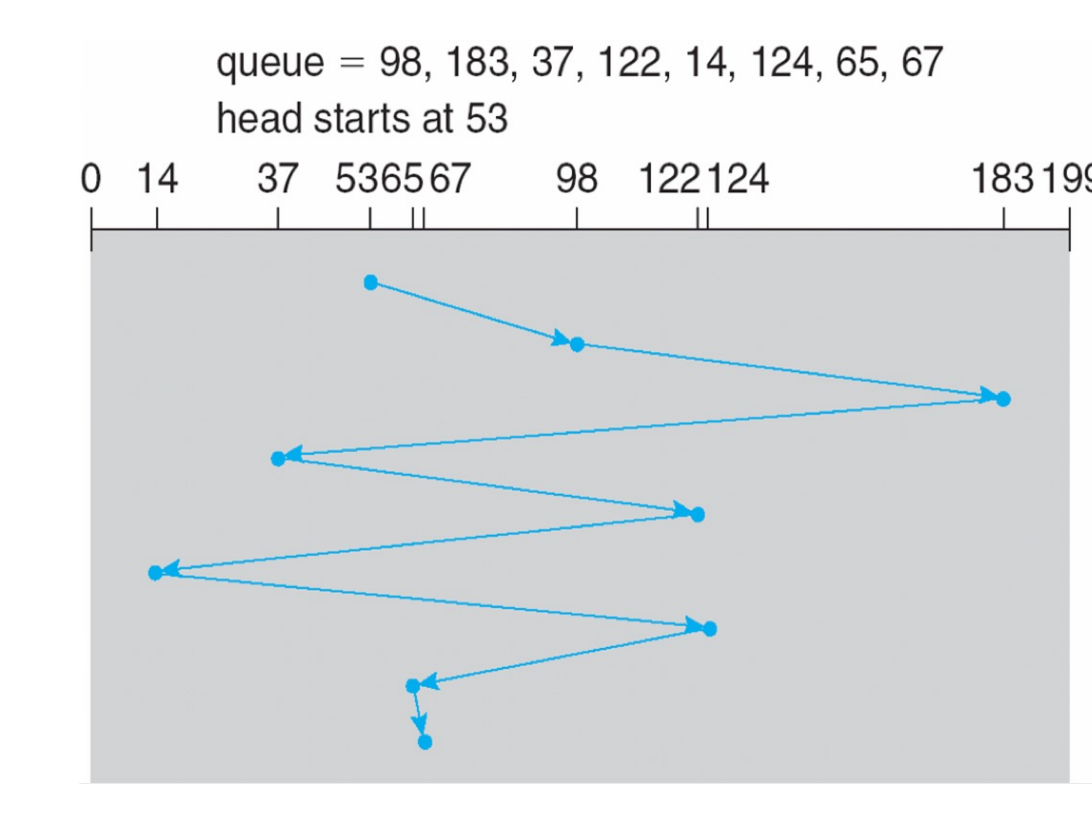
- Advantage:
- Every request gets a fair chance
- No indefinite postponement
- Disadvantages:
- Does not try to optimize seek time
- May not provide the best possible service
SSTF#
shortest seek time first.
类似 SJF,选择离现在 head position 最近的 request。但是 SSTF 不一定最好。可能发生 starvation。
Example

-
Advantages:
- Average Response Time decreases
- Throughput increases
-
Disadvantages
- Overhead to calculate seek time in advance
- Starvation may exist
- High variance : favors only some requests
SCAN#
也叫 elevator 电梯算法,先扫到一头,再往另一头扫,如果遇到 request 就读取。
Example
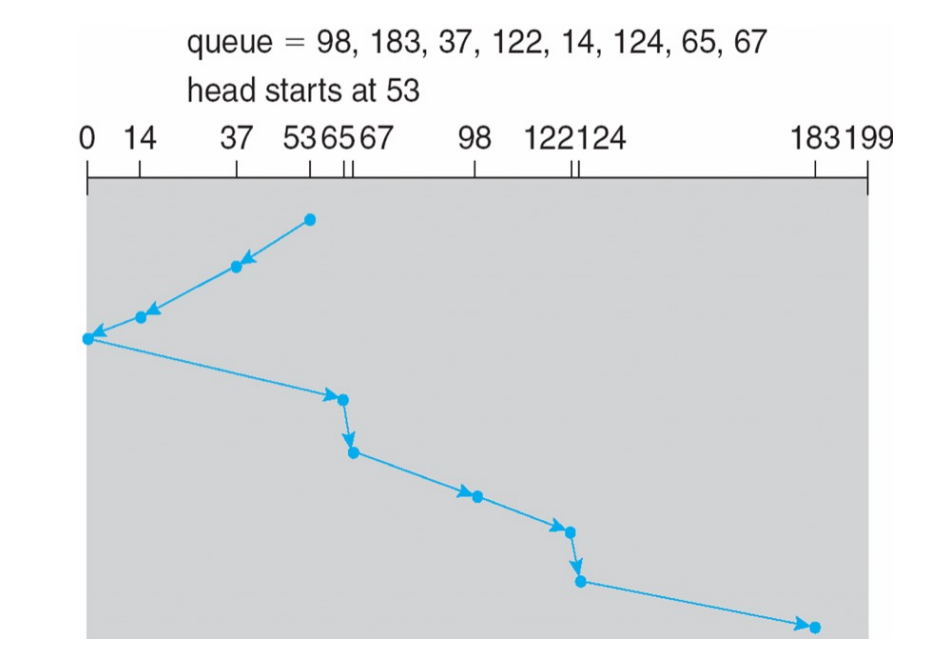
- Advantages:
- Average Response Time
- High Throughput
- Low variance of response time
- Disadvantages:
-
Long waiting time for requests for locations just visited by disk arm
如果刚好错过电梯,就要等电梯触底再上来,等待时间很长。
-
C-SCAN(Circular-SCAN) is designed to provides a more uniform wait time. 只做单向的扫,到达一端时立刻回到开头,随后从底往上扫,这样最多只用等待一圈。
LOOK#
在 SCAN / C-SCAN 的基础上,只走到一端最后一个任务(look 是否有请求)而不走到 disk 的头。
LOOK is a version of SCAN, C-LOOK is a version of C-SCAN.
Example

- Advantage:
- Prevents the extra delay which occurred due to unnecessary traversal to the end of the disk.
Selecting Disk-Scheduling Algorithm
依赖于请求的模式,而请求本身又依赖于文件分配策略。文件系统如果注重空间局部性,能够提供很好的表现提升。
如果 I/O 比较少,FCFS 和 SSTF 即可。如果是大型的服务器或者数据库,一般使用 C-LOOK。如果是 SSD(不用 seek),一般使用 FCFS。
Nonvolatile Memory Devices#
If disk-drive like, then called solid-state disks (SSDs).
固态硬盘
Can be more reliable than HDDs,
与磁盘相比,寿命短,容量小,速度快(Bus 慢,需要直接连到 PCIE 上)。没有 arm 也不需要转,因此不存在 seek time 和 rotational latency.
-
Read and written in “page” increments (think sector) but can’t overwrite in place.
- Must first be erased, and erases happen in larger “block”
- Assume block size: 64k
-
Can only be erased a limited number of times before worn out – ~ 100,000
寿命短,里面是用门电路实现。充放电(擦写)门会被击穿,就无法区分 0/1 了。
-
Life span measured in drive writes per day(DWPD)
Each cell has lifespan, so need to write equally to all cells.
Magnetic Tape#
磁带,容量很大,但是很慢。因为需要倒带,一般都做顺序访问而不是随机访问。现在主要用来做备份。
data stored on the tape are relatively permanent.
Disk Management#
使用这些介质(磁盘、固态硬盘、磁带)的时候,需要先格式化。
u盘使用FCFS
Physical formatting: divide disk into sectors for controller to read/write.
即把介质上分好不同的部分。
- partition disk into groups of cylinders, each treated as a logical disk.
- logical formatting partitions to make a file system on it.
Disk Attachment#
-
host-attached storage
-
hard disk, RAID arrays, CD, DVD, tape...
可以插到 I/O Bus 上。

-
-
network-attached storage
- storage area network
RAID#
Disks are unreliable, slow, but cheap. Simple idea: let’s use redundancy to improve reliability and speed.
HDDs 越来越小和便宜,因此如果一个系统可以拥有大量磁盘,那么就能改善数据的读写速率(因为可以并行)和可靠性(使用冗余来降低出现错误的期望)。这样的磁盘组织技术称为 磁盘冗余阵列 (Redundant Arrays of Independent Disk, RAID) 技术。
-
Data Mirroring
- Keep the same data on multiple disks
-
Data Striping
- Keep data split across multiple disks to allow parallel reads
-
Error-Code Correcting (ECC) - Parity Bits
- Keep information from which to reconstruct lost bits due to a drive failing
这里 RAID 0 的技术主要是 Striping,RAID 1 的技术主要是 Mirroring,因此我们有时会说 5+1,5+0,表示几个技术结合。
RAID 0#
没有 redundancy,什么也不做,把数据分散在不同的磁盘。
Improves performance, but not reliability.
Example
- Fixed strip size
- 5 files of various sizes
- 4 disks
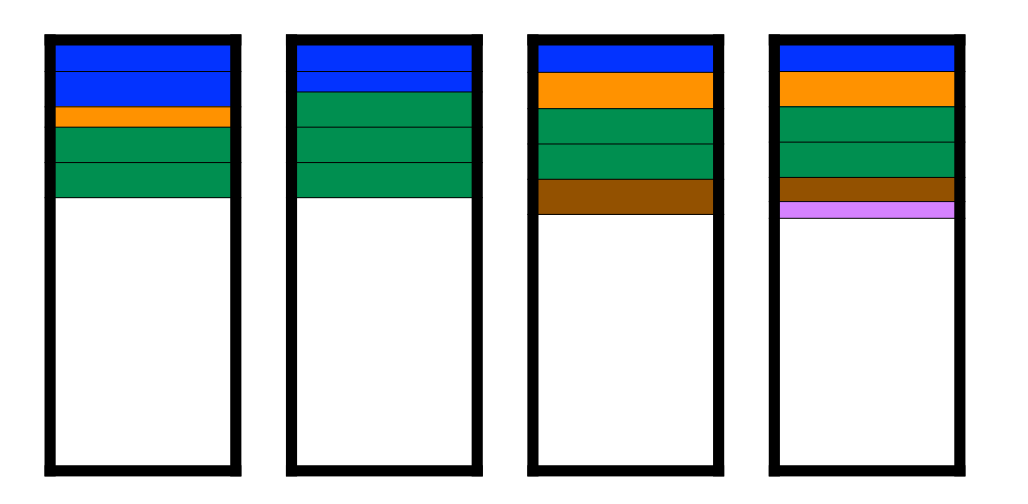
RAID 1#
也被称为 mirroring,存在两个磁盘,一个是主磁盘,一个是备份磁盘。主磁盘写入数据后,备份磁盘也写入相同的数据。
Example
- 5 files of various sizes
- 4 disks
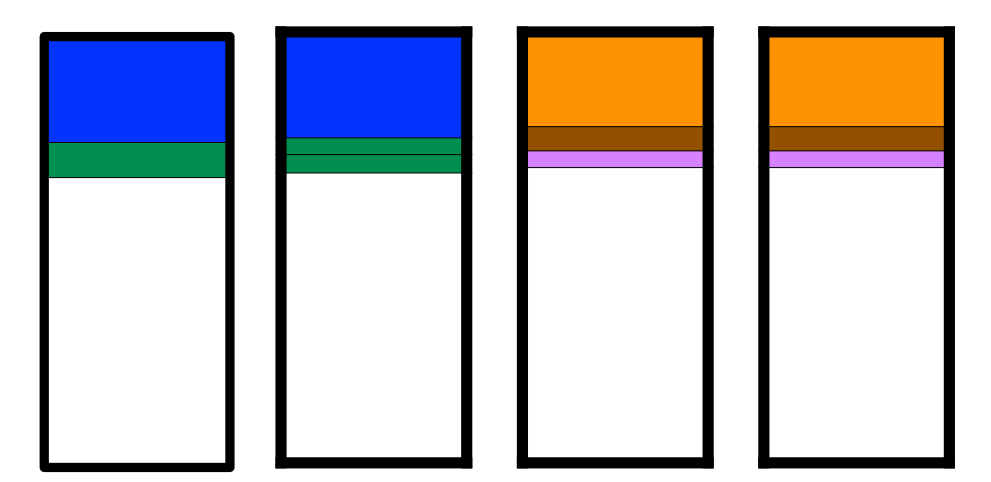
Reliability is ensured unless you have (extremely unlikely) simultaneous failures, performance can be boosted by reading from the disk with the fastest seek time.
但是浪费了一半的磁盘。
RAID 2#
stripes data at the bit-level; uses Hamming code for error correction (not used).
没有被实际应用,因为粒度太小,现在无法单独读出来一个比特,至少读出一个字节。

RAID 3#
Data is striped across multiple disks, with one dedicated parity disk that stores the parity information for all the data disks.
纠错码就在一个磁盘里。

RAID 4,5,6#
-
RAID 4: Basically like RAID 3, but interleaving it with strips (blocks)
用块来做 strip,纠错码单独存在一个盘里。这个纠错盘一直会被读写,很有可能先损坏。
-
RAID 5: Like RAID 4, but parity is spread all over the disks as opposed to having just one parity disk.
parity bit 被分散地存到了不同的磁盘里。相比于 RAID 4,每个盘的读写比较均衡。
-
RAID 6: extends RAID 5 by adding an additional parity block.
又加了一个 parity bit,也是分散存储。

RAID and File Systems#
RAID 只检测磁盘失效,并不知道对应的是哪个文件失效。
ZFS adds checksums to all FS data and metadata.
这样可以检验磁盘是否写错。
Takeaway#
Takeaway
- Disk structure
- Disk scheduling
- FCFS, SSTF, SCAN, C-SCAN, LOOK, C-LOOK
- RAID 0-6
Created: 2024年9月17日 14:52:21